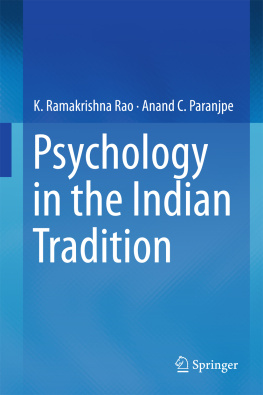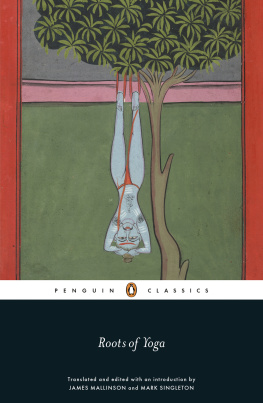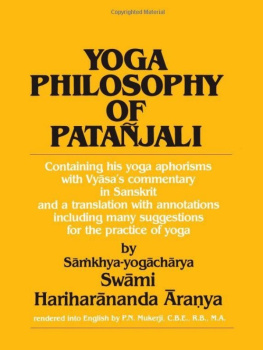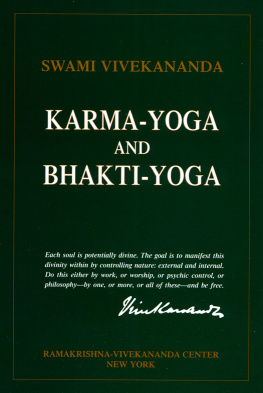Background
The metaphysical base of Yoga is the Skhya system, which is the oldest of the six classical systems of Indian philosophy. Yoga shares the Skhya dualism of consciousness and matter, purua and prakti . What is of interest here, unlike in the Western philosophies such as Descartes radical dualism , is that a distinction is made between mind and consciousness and not merely between mind and matter. Skhya-Yoga considers the mind, sensory system and the ego material along with gross matter. Thus, matter has two distinct forms, one in the mind and the other in physical objects. Consciousness- as - such , however, belongs to a different realm of reality. Now, important implications ensue from the postulation of two kinds of matter involved in mental phenomena on the one hand and the physical objects on the other. Matter in its wider sense, which includes the mind as well, is constituted by three primary elements called guas . They are sattva , rajas , and tamas . These are common in minds as well as physical things. They are involved in the manifestation of mental phenomena as well as in the evolution of physical objects. Thus, they provide the common ground between mind and material objects. This is explained by Vcaspati in the following words.
The qualities ( guas ) appear as possessing two forms, viz. the perceived or the determined and the determiner or the perceiver. In the aspect as the determined or the perceived the guas evolve themselves as the five infra-atomic potentials, the five gross elements and their compounds. In the aspect as the perceiver or determiner they form the modifications as the ego and the senses.
Quoted from Dasgupta (, p. 3)
As Dasgupta () explains, there is no fundamental difference between the objects of perception and the perceptual process. The only distinction between them is that one is determined while the other is the one that determines. There is, however, a crucial difference between the perceiver and the objects perceived. The perceiver is the purua , and the objects perceived are the manifestations of the prakti . This calls for an understanding of the relation between purua and prakti , which is variously conceived by different philosophical systems, for example. Skhya-Yoga and Vednta .
Within the tradition of the Vedanta, the relation between purua and prakti , subject and object, is explained in at least three different ways. (1) Prakti is My, which has no beginning and is ubiquitous . It reflects the purua as in the case of sun reflected in a pool of water. This is known as reflection theory of the relation between purua and prakti . (2) The limitation theory postulates that the mind limits the all-pervasive purua like the jar limiting the space, which by itself is limitless. (3) The third view holds that the purua is neither reflected in nor limited by the mind. Rather it is simply misidentified by the person because of ignorance .
The approach of Skhya-Yoga is quite different. Prakti and purua are two distinct realities. One cannot be eliminated or reduced to the other. The former is ever changing, whereas the latter is utterly changeless. However, in the person, when the buddhi reflects the purua , the manifest reflection engenders the sense of the ego. Cast into the mold of the buddhi , purua then becomes personal consciousness, individualized and self-indulged.
The person has the experience of the purua through the instrumentality of the buddhi which has the capacity to reflect the purua , because of its sattvic component. Buddhi in its purest form is nearly indistinguishable from and is as good as purua . Consequently, the reflections are as good as the objects of its reflection. However, the reflections in human condition are ordinarily blemished by ego involvement. The liberation of the person consists in achieving such a state/purity of the buddhi that the image it has of the purua is indistinguishable from the purua , made possible by transcending the limitations of ego involvement and by cultivating unblemished buddhi .
As Vysa explains, buddhi is neither similar to nor different from the purua . It is different in that, unlike purua which is changeless, it incessantly undergoes changes. It is the similar to the purua when it reflects purua without any blemishes and thus becomes indistinguishable from it. Personal consciousness has two interrelated components. One is the object revealed, and the other is the light of consciousness that makes sense of the object. In human experience, they go together. The purua , like the magnet that attracts the iron filings, draws the objects of prakti to its fold. This is the kind of interaction that takes place between the purua and the prakti in human condition. The object revealed is changing, and the light revealing the object is changeless. We may recall that the object revealed is a manifestation /form of the buddhi , which becomes visible and gains meaning when the light of purua shines on it. Pure and unblemished buddhi is able to reflect the purua in its true form. When this happens, purua and its images in the buddhi become indistinguishable from the purua itself. This indeed is the state of kaivalya , the goal of ones being. So, the Yoga - Stras asserts that when the sattva or buddhi becomes as pure as purua , one attains kaivalya , unity between prakti and purua ( Vibhti pada , stra , 56).









